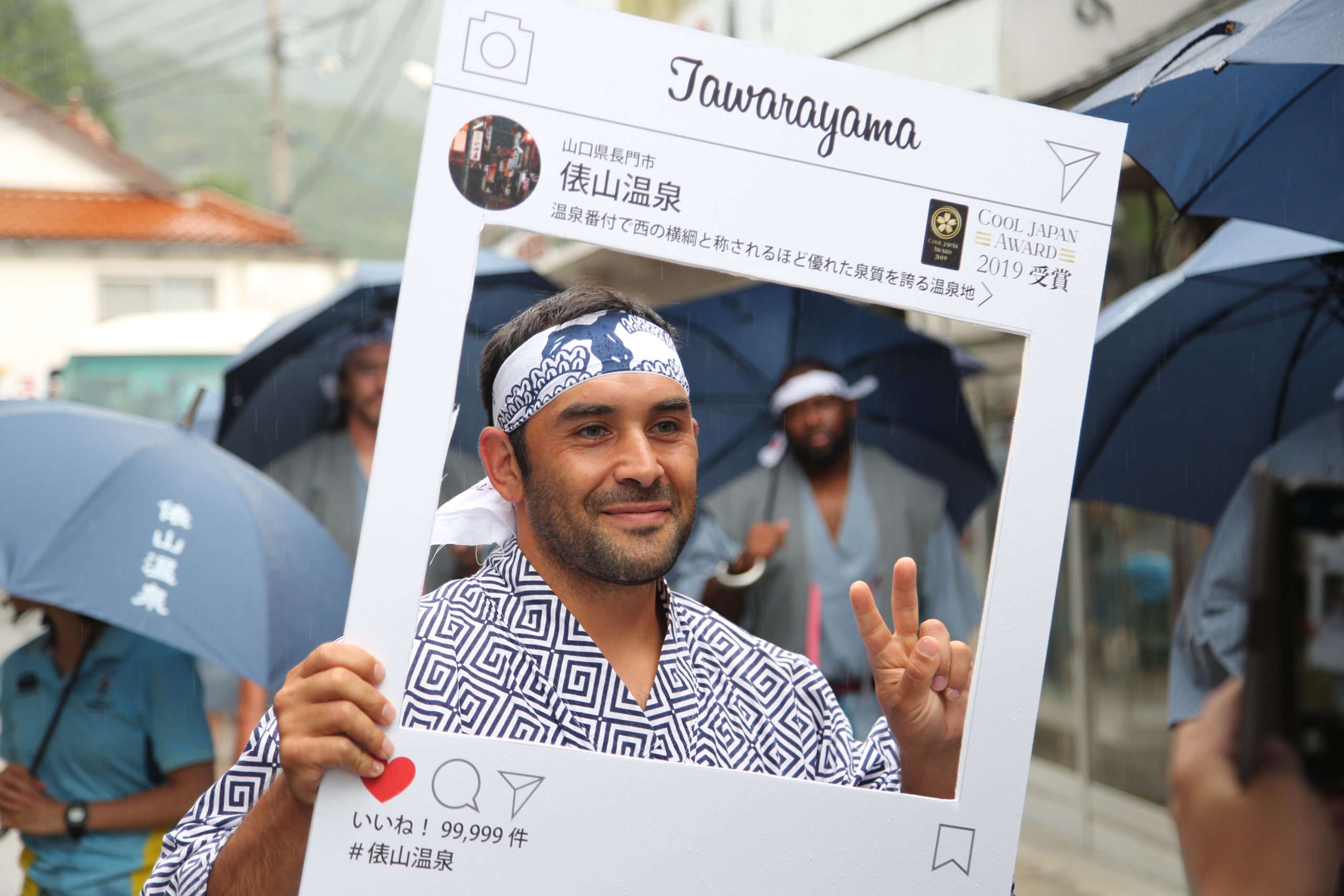- >
- Nanavi News
- >
- 11 days in Nagato, the camp site] “Thank you” to the Canadian national team (Part 2)
11 days in Nagato, the camp site] “Thank you” to the Canadian national team (Part 2)
-
Last updated:
Oct 23, 2019
-
About the writer:
Nagato Tourism Convention Association

Thank you for visiting!
Ahead of the Rugby World Cup 2019 in Japan, the Canadian national team spent 11 days from Thursday, September 12 to Sunday, September 22 in Nagato City, which served as their pre- and official camp site.

After their final match in Kamaishi City, Iwate Prefecture, was cancelled due to Typhoon No. 19 and the team was eliminated from the qualifying round, the team remained in Kamaishi City, which still bears the scars of the typhoon, to participate in volunteer activities to remove sediment and mud. Their compassionate actions made headlines and garnered great praise.
The Canadian team practiced hard in Nagato City, the first camp site after their arrival in Japan, and on Sunday the 15th and Friday the 20th, which were rest days, they enjoyed seven hands-on tours in the city. Many people said they became fans of the team because of their friendly attitude and enjoyment of interacting with local residents through their experiences, making it an unforgettable 11 days for the citizens.

Photo exhibition at the entrance lobby of Nagato City Hall from October 15 (Tue.)
This report, divided into Part 1 and Part 2, looks back with gratitude on the days spent with the Canadian national team from the perspective of the Nanavi staff who were involved in planning and filming the experience tour. The second half of this report focuses on the time spent at Tawarayama Onsen, where the team's appearance in yukata (light cotton kimono) attracted much attention.
Enjoy Tawarayama Onsen and soba noodle making
Friday, September 20 was the last rest day during the camp.
On this day, we were divided into three groups, Tawarayama, Aomi Island, and Yumoto, and each group went to the site of the hands-on tour.

About 30 local residents, including school children, were waiting in the light rain at the Satoyama Station Tawarayama. They held up a banner that read "Good Luck" and greeted the players with high fives.


Here, visitors can experience soba noodle making with local masters using buckwheat flour produced in Tawarayama, starting with the kneading of the flour.

The dough is then rolled out with the hand curled up like a cat's, and the dough is gently handled with the rolling pin.


In such delicate processes of stretching thin and cutting thin, they faced the soba with serious expressions on their faces. Perhaps because they were much stronger than the average person, they were able to produce firm soba in a shorter time than usual.



Even with the sauce and condiments in front of them, they were not sure how to eat it at first. But after taking a bite, they all said "Delicious" and smiled. At the end of the event, a commemorative photo was taken with the people of Tawarayama, with the call out "3, 2, 1, SOBA!



Next, we boarded a bus to the hot spring resort of Tawarayama.

On the bus, many of the players changed into "My Yukata" by themselves and appeared at the entrance to the hot spring resort. They cheered "Oh!" but they had trouble putting on their geta, so they had to be taught by local residents on the spot.

After strolling through the hot spring resort town under an umbrella, we went to "Hakusaru no Yu" (White Monkey's Hot Spring) at Tawarayama Onsen. The outdoor hot spring bath helped to relieve practice fatigue, and the group also tasted Tawarayama's famous sweets, "Sanzaru-manju" (three monkey buns).




The Tawarayama area was visited by many people this fall, including rugby fans, as the Canadian national team practiced at the Tawarayama Spa Stadium (Tawarayama Multipurpose Exchange Plaza). The camp was a valuable opportunity for this quiet hot spring resort in the mountains to show the world what it has to offer.

Seine netting experience on Qinghai Island
The group headed for Aomi Island, located in the north of Nagato City, to experience seine fishing with children from Tori Elementary School. They took off their clothes, entered the sea, and pulled the net with all their might to catch fish.



Afterwards, they also experienced fishing on the breakwater around "Roadside Station Senza Kitchen. The participants grilled food at the "Grill House," a barbecue facility nearby, and enjoyed seafood from Nagato.


Experience the history and culture of Yumoto
The Fukagawa Kiln of Hagi ware has a history of over 360 years in the Minose district of Fukagawa-Yumoto, Nagato City. Even today, five kilns continue to produce pottery.

The group headed this way visited the Tahara Tohei Studio. They observed the climbing kiln and pottery making while receiving an explanation from Tohei Tahara XIII, and also experienced a tea ceremony and tasted powdered green tea.


After that, we moved to Daneiji Temple to experience Zen meditation.
In addition to nature and food, visitors also experienced the charms of Nagato City's history and culture.


Thank you" to the Canadian National Team
Through the two-day experience tour and open practice, the Canadian national team shared a time that will surely be a once-in-a-lifetime experience with the citizens of the city. The players also shared their time spent in Nagato City with the world on their own Instagram with the hashtag #nagatoiscalling.
The Rugby World Cup 2019, the first ever to be held in Japan, was an unforgettable tournament for Nagato City. To the Canadian National Team, thank you so much for the many surprises and memorable moments.



